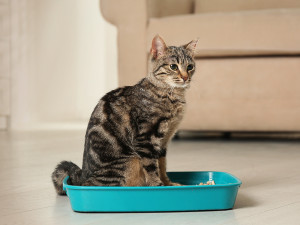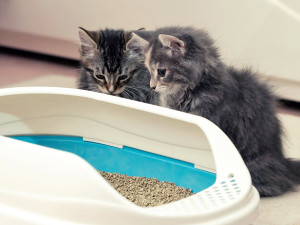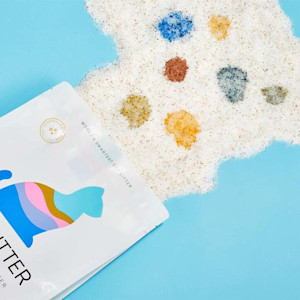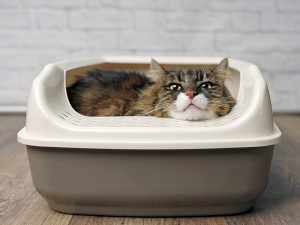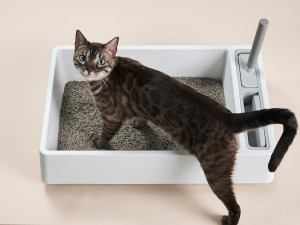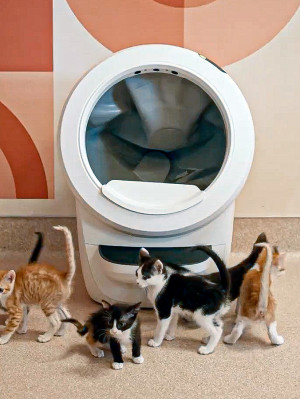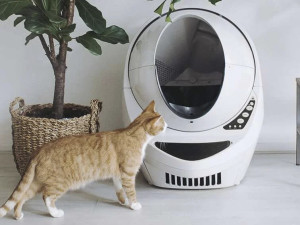Can You Flush Litter?
No. And here’s why.
In This Article:
Can You Flush Cat Litter Down The Toilet? Flushable vs. Non-Flushable Cat Litter What Happens If I Flush Cat Litter Once in a While? Eco-Friendly Alternatives to Flushing
When you are so in love with your feline friends, it can be pretty easy to overlook some of the more unpleasant parts of having a cat. Unexpected hairballs, random puke, and making messes all just feel par for the course. An everyday reality with living with a cat, however, is making sure they have a clean litter box, ready for them to use when they need to use the bathroom. All cats have specifics in terms of what they like for their box, and some are certainly pickier than others.
Making sure that your cat’s litter box is clean and freshopens in new tab for them every day might have a cat parent thinking about alternative ways to dispose of your cat’s litter. What might seem easiest is flushing your cat’s waste and litter. You use the bathroom to get rid of your own you know, so why can’t you do the same for your cat? While it might seem like a convenient method to disposal method, there’s many consequences for plumbing, the environment, and other mammals.
Can you flush cat litter down the toilet?
Potential for clogged drains and plumbing issues
While flushing cat litter might seem convenient and easy, there’s still the potential for it to cause major issues when it comes to plumbing. Flushing any cat litter can cause plumping and clogging issues, but especially any litter that contains clay. Clay litter absorbs liquid (see the clumps in your cat’s box), so when it gets wet, it expands. Flushing it could cause major blockages when it expands and gets heavy. Many states have “cat litter” on their do-not flush lists.
How much do you spend on your pet per year?
Environmental concerns and water contamination
Aside from just blocking an individual’s pipes, flushing cat litter can cause problems for your street or even your whole neighborhood’s sewage line. Aside from just blocking pipes, some litters also contain silica and other eco-unfriendly ingredients that shouldn’t end up in water sources.
Even your cat’s waste shouldn’t be something that goes into human water sources — it can introduce harmful pathogens and parasites into the water which can infect other humans and animals through the water supply. One of those includes Toxoplasma gondii, which is found in cat feces. It can cause serious illness in people with weakened immune systems and cause pregnant women to miscarry or serious fetal issues.
Can flush cat poop with litter?
You can, but it’s not a good idea. Most of the time, cat waste will still have some litter clinging to it, which can cause blockages. And, generally, most resources will say flushing animal waste of any kind isn’t advisable because it can introduce harmful things into a community’s water supply.
Flushable vs. non-flushable litter?
Can you flush cat litter crystals?
Like with most litters, it’s recommended that you don’t flush any of them. Cat litter crystals have silica in them and don’t dissolve in water, which can cause potential clogging.
Can you flush clay cat litter?
You cannot flush clay litter because it’s liquid absorbent. So, while this makes it great for keeping your cat’s litter box tidy by clumping up waste, it will do the same thing if you flush it: It will expand, absorb liquid, and potentially cause blockages. This might not just create problems for your personal pipes, but also the whole neighborhood’s.
Can you flush biodegradable cat litter?
Even litter that is biodegradable, with ingredients like corn, paper, and tofu, is more about being environmentally-friendly than truly flushable. Despite those ingredients, the litter can still cause clogs. Even if it doesn’t, you are still putting cat waste into the water source, which can eventually cause all kinds of other problems.
What happens if I flush cat litter once in a while?
Even flushing cat litter once in a while may still cause problems. You are at risk of causing a major plumbing problem — many litters, including the biodegradable ones, can still cause blockages (especially clay-based litters).
These litters may also have non-eco-friendly ingredients in them that shouldn’t be introduced into the water source. Putting any cat waste into a water source can leave other humans and animals at risk for illness because of the parasites found in a cat’s waste. Plus, these toxins might also get into larger bodies of water, causing potential harm to marine life.
Eco-friendly alternatives to flushing?
Biodegradable litter and composting
Most biodegradable litters, while advertised as flushable, are really just eco-friendly options for disposing of your cat’s waste. They can be made of all types of ingredients, including environmentally-friendly walnut shells, corn, and wheat. Many clay and silica-based litters end up in landfills because they aren’t biodegradable. Due to this, biodegradable litter can be a better option.
Many biodegradable litter options can be composted, but, like flushing litter, there are places where you don’t want to introduce your cat’s waste. Due to the Toxoplasma gondii that can be found in cat feces, you will only want to compost used cat litter in flower beds or any sort of garden that doesn’t have edible plants. This is because this toxin can cause major illness in humans. And if you are just putting your litter in a compost heap, you'll want to be sure there’s no cat waste before you put it in.
Disposal in the regular trash
Sometimes the simplest solution is the best. For cat waste, it’s as easy as bagging the waste before putting it in the trash. Using a biodegradable bag to scoop up the waste is key, rather than just scooping it straight into the trash. The biodegradable bag will give it a better chance to break down once it’s at the dump, but any sort of bag that will seal the waste can work, too.
Best practices for cat litter disposal
Using a biodegradable litter made out of organic material is the most environmentally friendly way to start your cat’s litter box. By using biodegradable litter, you'll have more options in how you dispose of the cat waste, but remember — never flush!
With biodegradable litter, you can compost the litter, but make sure to only do so in gardens that don’t have plants that humans might eat, since there’s a chance that parasites could infect the soil growing the plants. The tried and true way to get rid of cat waste, however, is simply to scoop it into a bag, tie it up tight, and throw it in the trash. While a regular plastic bag works, buying specific biodegradable bags for cat litter is better for the environment.
FAQs (People also ask):
Can you flush clumping cat litter?
You can absolutely not flush clumping cat litter. Most clumping cat litters have clay in them, which absorbs your cat’s waste and makes it easy to scoop up. By flushing that litter, the clay can absorb the water, expand, and harden, which can cause major blockages in a personal sewer system and problems with an apartment complex or even street’s plumbing lines.
What is the best flushable cat litter?
While some biodegradable litters may advertise that they are better for flushing, they still contain ingredients that can cause plumbing issues. And in general, even if a litter was flushable, you still wouldn’t want to flush it. Putting cat waste into a water system can be dangerous for humans and animals alike.


